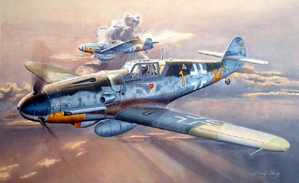
Trumpeter 1/32 Messerschmitt Bf109G-6 (Early)
By Jacob Russell
The Plane
The Messerschmitt Bf109G-6 had upgraded cowling armament and it was equipped with a pair of 13mm MG 131 machine guns instead of the 7.9mm MG 17 guns of earlier variants. The new guns had larger breech blocks and cocking mechanisms. In order to fit them under the cowling two bulges (the so-called "Beules" or bumps) were added to the cowling just in front of the windscreen. Another visual difference was the cowling's gun troughs: these were an insert on the cowlings of earlier Gustavs and a straight press fit, mounted further back, on the G-6.
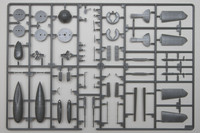
The G-6 used the G-3's machined wheels, larger tires and tail wheel, with the associated upper wing bulges. Early planes had a long antenna mast and solid metal canopy armor, while late G-6s had a short antenna mast, armored glass canopy armor, and FuG 16ZY D/F loop. Both early and late variants had the lower fuselage antenna for the FuG 25A IFF (Identification Friend/Foe) equipment.
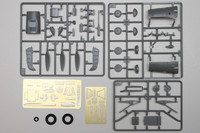
Some G-6s used tall wooden tails and the Erla Haube clear vision hood, with its associated "Galland Panzer" armored glass canopy armor. Widely used variants included the R-3 with 300 litre drop tank, the R-6 with MG 151/20mm cannons in under wing pods (the so called "Kanonenboote"), and the R-2 reconnaissance fighter with the Rb 50/30 camera installation.
A small number of G-6 aircraft were fitted with the DB 605AS engine. The G-6/AS had an enlarged supercharger with a larger port side engine bearer mount that required a redesigned, larger cowling with asymmetrical bulges. This cowling eliminated the need for the "Beules" (bumps) of non 605AS equipped aircraft.
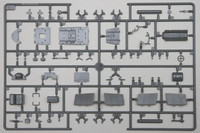
The Kit
Trumpeter's Bf109G-6 comes in a stout cardboard box. It consists of 289 parts, 34 of which go unused. 236 of these parts are molded in grey plastic on 10 sprues, 11 are clear plastic on 3 sprues, there are 3 rubber tires, and 39 photo-etched parts on 2 brass frets. All of the parts are bagged in groups and the brass frets have a cardboard backing piece to boot. The clear parts, rubber tires and p/e are segregated in the box with the aid of a cardboard separator. There are 2 decal sheets and they are also separately bagged. The initial impressions are of complexity and quality.
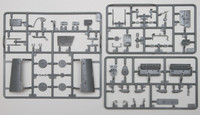
The kit includes a complete engine with separate cowls, so that it can be displayed. The upper MG 131s are included and mount directly above the engine. You will have to remove the aft upper decking from each fuselage half, between the cowling and windscreen, to display the gun breeches and ammunition chutes. The latter items are conspicuous in their absence, so you will have to fabricate them or look for aftermarket help. The cockpit is well detailed. The instrument panel consists of 3 pieces: a clear panel, instrument face decal and a backing piece. Because the instrument panel is clear, and the decal slightly out of register, I would probably paint the panel RLM 66 and use a punch set to punch out the individual instrument decals and apply them one by one. Another omission, albeit minor, is the sight glass in the fuel line on the starboard sidewall. It is molded in grey plastic. You can cut the line in two and use either clear rod or stretched sprue to depict the sight glass. The p/e cockpit parts include the seat, rudder pedals, harness, trim wheel and canopy armor. There is also a plastic seat if you're disinclined to fold up the p/e one. I think that whether or not you modify the fuel return line the cockpit will look great with an oil wash and some expert dry brushing.
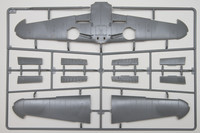
The Daimler Benz DB 605A-1 inverted V-12 engine is well executed and bristling with detail. The exhaust stacks are individually molded and their ends are drilled out: nicely done! The engine mounted MG 151 cannon is a multi-piece assembly, and there's a nicely done cannon breech cover for the cockpit. The 2 piece supercharger looks nice and so do the engine bearer arms.
The landing gear are well executed. They include separate oleo scissors, brake lines and p/e straps to attach the brake lines. The landing gear doors are well detailed and any ejector pin marks will be hidden by the gear themselves. The wheel faces are well detailed, but I can live without the vinyl tires, thank you very much! Over time the vinyl tires and styrene wheels will react to one another, and not in a positive way. I bought a pair of Roy Sutherland's Barracudacast resin wheels (item number BR32072 with plain hub and ribbed tire) for my kit. The tail wheel comprises 5 parts-vinyl tire, 2 part tail wheel and a 2 part yoke, but the prominent canvas cover fitted to the majority of G-6 tail wheels is missing. Not all G-6s had the cover and it is easy enough to make from tissue soaked in white glue, but it's absence is a bit surprising.
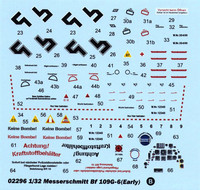
The propeller and spinner look the part. The prop blades and hub are separate pieces. The blades look pretty good. The cannon opening in the spinner looks small. The horseshoe shaped oil cooler just behind the prop looks accurate.
The wings have separate flaps, ailerons, and leading edge slats. The fabric detail on the ailerons is just slightly heavy handed. The kidney shaped upper wing bulges are individual pieces.
But they attach directly to the wings with a pair of tabs visible right where the wing clearance holes should be. I would remove the bulge mounting tabs and reshape their faces (that is, the flat face that lies on the wing) with a Dremel tool. Then I would cut out the clearance holes, slightly smaller than the bulges, of course, and then attach the bulges to the upper wing. This modification is a pain to be sure, but it results in greater accurate than the kit provides.
There are 3 decal options in the kit:
"Yellow 1", W.Nr. 20499, Erich Hartmann, 9/JG52, Russia, October 1943. The camouflage scheme is RLM 74/75/76 with RLM 04 yellow wing tips, forward lower cowl and partial fuselage band. The spinner is 2/3rds RLM 66 and 1/3rd white.
"White 11", 1/JG27 France 1944. The camouflage scheme is RLM 74/75/76 with a white rudder and RLM 83 green fuselage band. The spinner is RLM 66.
"Red 29", 1/JG 302, Finland 1944. The camouflage scheme is RLM 74/75/76 with RLM 04 rudder. The lower port wing is black, and the upper fuselage and wings are over painted with RLM 76 blue squiggles. The spinner is half RLM 66 and half white.
The kit has color callouts for Humbrol, Model Master, Mr. Hobby, Tamiya and Vallejo paints.
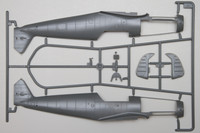
Accuracy
The Trumpeter fuselage is slightly long, according to a thread on the Large Scale Planes forum. The generator cooling scoop underneath the starboard cowling bulge should be removed, as it wasn't fitted to most G-6s. The lower fuselage just aft of wing is flat and it should be curved, and the upper and lower forward cowling is too long, placing the exhausts more rearward than it should be.
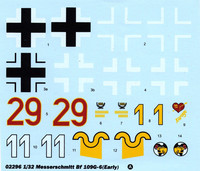
Conclusion
I like this kit. It is pretty accurate and well detailed and I like the open cowling option to display the engine. Ditch the vinyl tires in favor of aftermarket replacements; the rest of the kit contents are sound. I recommend this kit and I would like to thank Stevens International for supplying the review sample.
References
Messerschmitt Bf109 in action Part 2, by John Beaman, Squadron/Signal Publications, 1983
The Last of the Eagles, A Scale Modeler's Guide To The Messerschmitt Bf109G And K, by John Beaman, 1976
Messerschmitt Bf109G/K Vol.1, by Jakub Plewka, Kagero Publications, 2005
